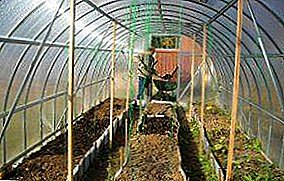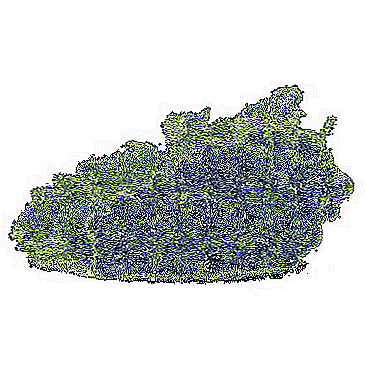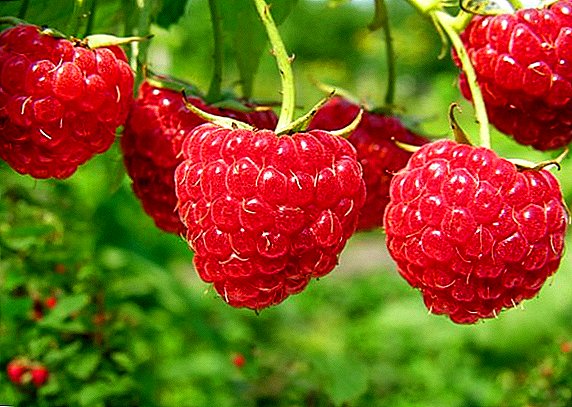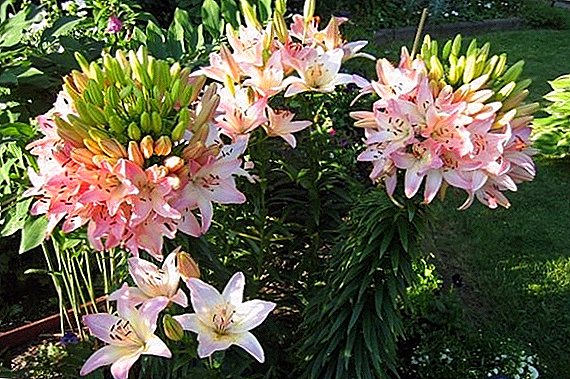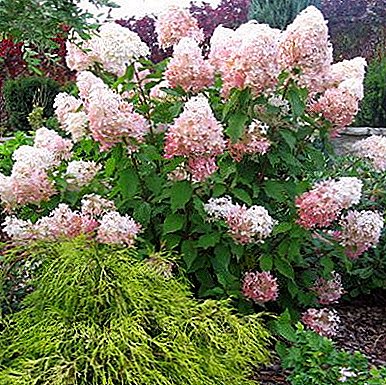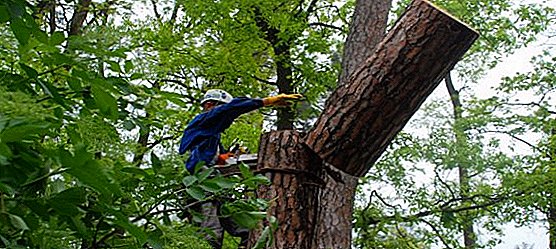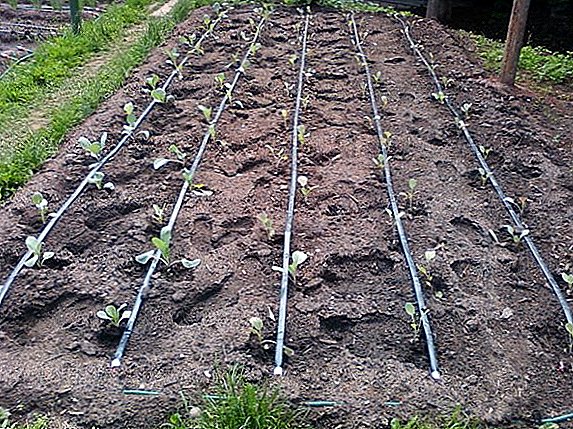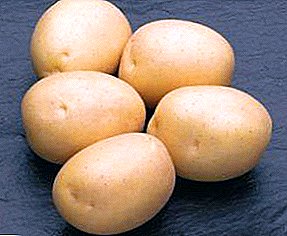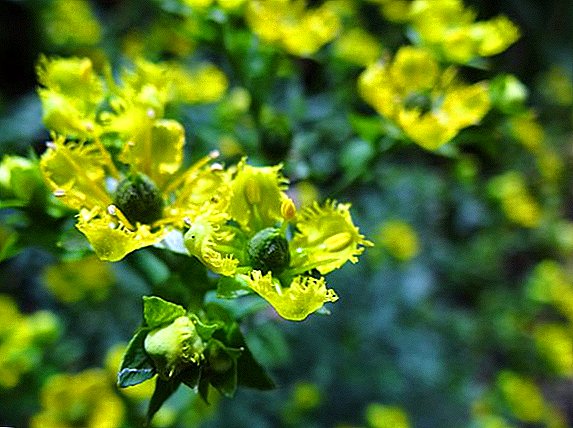 It is difficult to imagine that someone does not know about such a plant as root.
It is difficult to imagine that someone does not know about such a plant as root.
Its history goes back several thousand years, and all this time it has been widely used in traditional medicine and in everyday life.
Now this flower is actively used in cooking, pharmaceuticals, and also some antidotes are prepared from it. It occupies a place of honor in the modern folk medicine.
However, we already began to forget that this plant is a great guest in your flower bed. The perennial grass of the root will wonderfully grow and smell in your area if you take a little care and attention when planting and then caring for the flower. And how to do it best - read below.
Did you know? According to folk legend, on the night of Ivan Kupala, the flower of the rue becomes red and the one who has time to pluck it will acquire deserved happiness.
Ruta fragrant: description of the plant
 Let's see what is this rue. This plant is a long-lived shrub, with a very peculiar odor, which not everyone can like. In the European territory, in the wild, the rue does not grow, so it can only be found behind the fence by a gardener.
Let's see what is this rue. This plant is a long-lived shrub, with a very peculiar odor, which not everyone can like. In the European territory, in the wild, the rue does not grow, so it can only be found behind the fence by a gardener.
The height of the bush is about 55-70 cm with a woody trunk and lower parts of the branches. Every year, non-stiffened shoots die out, and in severe winters the entire upper part of the rue can die (with the arrival of spring, it is completely restored from the root). The color of woody parts of the plant is rich yellow, and the leaves and the rest are green with a light gray tint.
In the summer period, neat bright yellow flowers appear and if you take a good look, you will see pale dots in the light - micro reservoirs with essential oil. In our latitudes, the flower of the rue lives a lot, and, more often, it feels great until the age of twenty.
Did you know? After drying, the leaves of the rue have a different, more pleasant aroma and no longer cause burns on the hands.
Choosing a place for rue on the garden plot
Fragrant Ruta is an unpretentious plant in terms of planting and care. Soil is not particularly important for him, so you can safely plant rue almost anywhere in your front garden. However, one of the important points when planting an odorous shrub is the absence of drafts (protection against them can be both natural and artificial). Due to its ornamental, lace-shaped leaves, the rue is often planted for border decoration. 
Requirements for soil for planting
Garden Ruta is a great lover of calcareous, loamy and crushed stone soils in which she feels best. The plant is sufficiently resistant to droughts and does not tolerate strong soil moisture. Before spring planting, even in the fall, it is necessary to deeply dig up the area and it is desirable to apply fertilizer in the form of humus. In spring, the earth can be loosened and dredged to a shallow depth. The shrub is not whimsical to the conditions of the soil and can live in one place for 5-6 years, while maintaining excellent flowering.
Important! In the dried form of the plant can be stored no more than one year.
What should be the lighting for the rue, where to plant the plant
Illumination for the rue, in the place where you are going to grow it, should be sufficient for normal development, but in the hottest time of the day, it is advisable to shade the bush for a couple of hours.
However, if for a rue to create a constant penumbra or a little more darkening, the leaves of the plant will begin to curl and turn yellow. So boldly, you can plant a flower in any place where direct sunlight falls.
How to plant rue: scheme and timing of planting
 It is possible to plant garden grass with odorous flowers in several ways: seed, by grafting or dividing the bush.
It is possible to plant garden grass with odorous flowers in several ways: seed, by grafting or dividing the bush.
According to the rules, the plant must first be grown on seedlings in pots, and only after that it should be planted in open ground.
Of course, the seeds can be sown immediately into the soil, but at the same time the consumption of seed material will increase, and even the ornamental value from the plant can be achieved only next year. When planting, it is also important to leave room for the growth of the rue, although with the observance of the 60x60 cm scheme, this is easy to do.
If you decide to grow seedlings, the seeds must be planted in early winter. In the open ground they are sown with the arrival of spring, and pickling seedlings or cuttings should be dealt with in the first days of summer.
Reproduction rue seminal method
The most convenient and popular method of rooting is considered to be its cultivation from seeds, so in order to learn more about the root, and to find out in detail what kind of plant we are, we recommend that you begin your acquaintance with it from seed propagation. If the flower is already growing on your site, and you have collected its seeds, or your friends have shared with you, they can be planted on seedlings at the beginning of winter, because they will take root only after a few months.
 For seedling growth, prepare a substrate of leafy earth and humus with a little sand added. The depth of sowing seeds should not exceed two centimeters. The soil should always be kept slightly hydrated, and it doesn't matter if you grow seedlings in a greenhouse or on a windowsill (the first shoots will appear in a few weeks).
For seedling growth, prepare a substrate of leafy earth and humus with a little sand added. The depth of sowing seeds should not exceed two centimeters. The soil should always be kept slightly hydrated, and it doesn't matter if you grow seedlings in a greenhouse or on a windowsill (the first shoots will appear in a few weeks).
It is better to plant the root immediately in separate containers, but The plant can easily transfer several picks.
Root rubs are transplanted to the site as soon as all threats of frost have passed: usually, this time falls at the end of May and the beginning of June.
Important! Root essential oil also has healing properties. But be very careful in its application, as a large amount of the substance can harm your skin.
Rule cutting
If you decide not to sow fragrant rue, then there is another simple way to reproduce it - grafting. First you need to prepare the cuttings, which are removed in early spring from last year's increments. After cutting, they are placed in a container with water for further rooting.
In the water, the branches of rue rooted for about one month, and the tank should always be in a warm place. Then, the cuttings are planted in open ground or substrate for further growth of the roots. 
If you put the cutting in the pot, then after 40 - 50 days it will be ready for picking on the site. But if you plant a sprig right in the open ground, you must cover it with a film and create light penumbra. In this case, rooting occurs in 50 - 60 days.
How to propagate the rue by dividing the bush
By dividing the bush, the rue is propagated in the spring or in the last month of summer. To do this, you need to dig a bush (preferably with pitchforks), examine it for negative growths (if any, carefully cut them with a sharp knife), and then also carefully cut the rhizome. Split bush should be immediately planted in prepared pits, having previously fertilized them with compost. You need to immerse the root to the same depth as it was before.
Growing rue, flower care features
Ruta does not need close attention. Just give her enough sunshine and do not overwet the soil - that's all the basic needs of a southern flower. Plant transplantation is needed very rarely (sometimes it happens once every ten years), but protection from drafts must be constant.  The plant rarely attacks diseases and pests, and its main enemy is weeds. Do not forget to weed the fragrant rue in time and loosen the ground in the area where it grows. It is also worth considering the fact that even though the plant is accustomed to our winters, it is best to shelter it for the time of cold weather.
The plant rarely attacks diseases and pests, and its main enemy is weeds. Do not forget to weed the fragrant rue in time and loosen the ground in the area where it grows. It is also worth considering the fact that even though the plant is accustomed to our winters, it is best to shelter it for the time of cold weather.
Important! Do not touch the flower with your bare hands. This will cause blistering and itching, while over-saturating it with juice or oil can lead to a decrease in heart rate, fever and even loss of consciousness.
How to water the rue
Ruta is a rather drought-resistant flower, therefore it needs only very hot days for watering. Any overmoistening of the soil can lead to diseases and partial death of the plant. Also, an extra event will be spraying the flower.
Features feeding plants
After winter, you can prune dead twigs and fertilize the root with a weak nitrogen fertilizer, although in general, the plant does not need special fertilizer. You can feed it only once a year, using complex compositions for this.
Pruning rue
Ruta responds very well to pruning. After the cold and you have released the plant from the winter shelter, you need to cut dead shoots to the buds. You can also remove weak and old shoots. If the plant is very neglected, it will be beneficially affected by deep pruning, in which only 15 to 20 cm of branches are left from the root. In addition, with the help of pruning, you can give the plant even more decorative and profitable to allocate a compact crown.
The toxicity of the rue
Despite its beauty, the described plant is quite poisonous. Therefore, using the root as a spice, to create some drugs, as well as in the treatment of traditional methods, do not forget that in large doses the plant can be very dangerous.
If the juice gets on the skin, there is a risk of getting burns and even dermatitis. This means that with any manipulation of fragrant rue you should always wear gloves. In addition, you should not take root (in particular, as a spice or as a medicinal plant) to pregnant women and people with stomach diseases.


